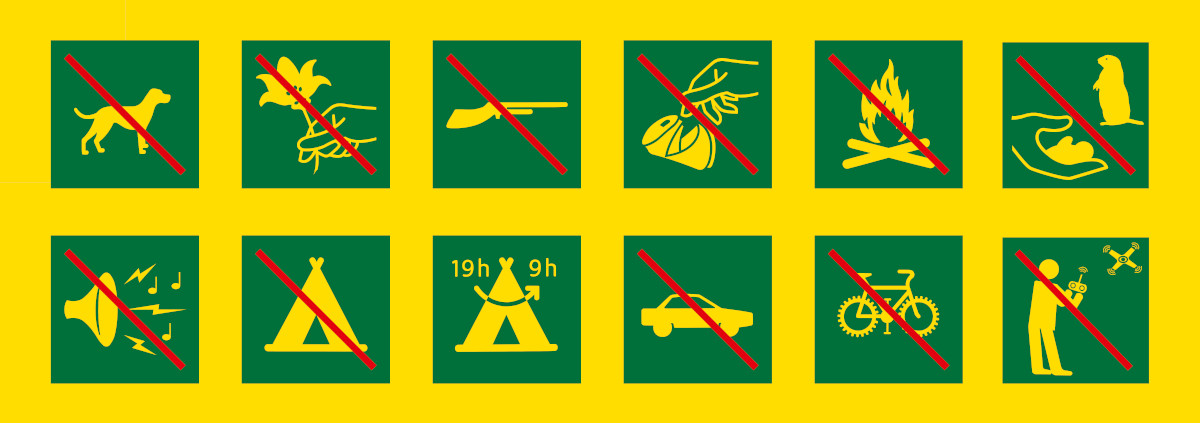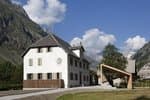Font Froide Mountain Pass
« One morning in July, leaving the forest, a cold wind came down from the rocky glacier at Font Froide. That is also where the glacial water from the source called Font (fountain) comes from... Decidedly, this mountain pass suits its name. But rapidly, the ascent warms the muscles and the whole body. The mountain pass is in view when a high pitched whistle makes me jump; it is a magnificent male ibex that moves away quietly two paces away from us ».
Dominique Vincent, park ranger, during an ibex count.
12 points of interest
 Fauna
FaunaRock Partridge
Here is another galliforme, like the Rock Ptarmigan, most easily observed during the springtime, but which lives at an altitude of 1500 m. The rock partridge lands on an outcrop to sing in a jerky way. It likes the sunny slopes with rocky crags like the sunny slope of the Pic de Pian going up to the Font-Froide Mountain pass.
 Glacier
GlacierFont Froide rock glacier
A rock glacier consists of a « concrete » of ice and rocks, which move slowly This movement creates morphology similar to a flow of larva. You can learn a lot from the one at Font Froide. Situated at the base of the summit of the Colle Blanche, it finishes at the bottom with a frontal moraine which is still active from which runs a water source which gives its name to the valley the « Font Froide ». Do not adventure on to it, the edifice is fragile! This place nicknamed « Casses labourées » was cursed by the ancients.
 Fauna
FaunaWall Creeper
A strange whistle can suddenly be heard in the mineral silence... above a cliff illuminated by the morning sun in May... you must scan the rock wall for a long time to find the “butterfly bird ". It flutters from place to place showing its beautiful red and black plumage with white markings. It is a real climber, the wall creeper clings on to the rock thanks to its long fingered claws. It catches insects and spiders in the cracks of the wall using its fine curved beak.
 Fauna
FaunaRock Ptarmigan
In the hope of seeing this bird, set off on a Spring night, ascend sharply to reach its terrain of choice at an alititude of more than 2000 m or even 3000 m before the sun comes up, listen to the characteristic guttural song that gives away its presence. But to see it, you must really open your eyes and use some binoculars. And then, pure happiness ! The Rock Ptarmigan is the most excellent alpine species, threatened like so many others by global warming. It is one of the protected species in the heart of the Ecrins National Park.
 Fauna
FaunaThe Ibex in Champsaur and Valgaudemar
Certain individuals in the ibex population reintroduced in Champoléon valley frequent the Font Froide mountain pass and its surroundings in summer. This year Hachka and Fleur, two females equipped with a GPS, have been able to have their movements followed.. They spent their summer between Le Pévou, la Cime des Moutières and le Pic de Pian, then the Font Froide mountain pass before migrating for the winter under the Puy des Baumes in the Champoléon valley. Will they return next year ?
 Panorama
PanoramaFont Froide Mountain Pass
The Font Froide mountain pass offers an exceptional view of the massif des Ecrins. In the distance, Barre des Ecrins, Pic Coolidge, Ailefroide, Les Bans,. And closer by the Pic de Colle Blanche, Brêche de l'Homme Etroit, Tête de Mal Cros, Pointe des Moutières, Pic de Parières, Aiguille de Morges. Right at the bottom, the Navette valley in the Valgaudemar. A high mountain atmosphere assured, accessible on a path.
 History
HistoryThe White Marble at Peyron Roux
Facing the Peyron Roux at an alititude of around 1700 metres, at a place called Cibet, a seam of cipolin was exploited locally before 1950. Remains of the access path, the old cabin and the treatment platform are still visible. The white marble from this site frame doors and windows in the hamlet of Molines most notably those of the chapel.
 Know-how
Know-howHorse drawn timber clearing
As a result of close collaboration between the Ecrins National Park and the National Forestry Office, timber felling was carried out with horses being used to clear the timber in the larch forest above Molines. This alternative solution was chosen in order to avoid having to create a forest road in the heart of the Park. An arrangement had to be made however to create access along approximately a hundred metres using two gangways for the approach of tractors collecting wood pulled by the horses. A very good operation that preserved the character of the site.
 Flora
FloraThe Autumn colours
This hike must be carried out in Autumn. The larch is covered in golden colours. The fruits of the Rose Bay Willow Herb bushes open liberating a multitude of seeds covered with a silky white down like snow. Higher on the shaded side, the blueberry plains are a beautiful red colour.
 History
HistoryForest and reforestation
At the end of the 19th century, there was a large local population the agricultural and pastoral space was at its maximum. It is at this time that devastating floods as well as epidemics and wars finished by discouraging the inhabitants. In the 1930s, the Eaux et Forêts undertook a vast program to restore the mountain terrains. This is how the larch forest was created above the hamlet of Molines.
 Flora
FloraLarch
The larch is a luminous essence that does not like competition from other trees. So it prefers to grow at altitude in conditions that are hostile to life, where others give up. The larch has also found its place at lower altitudes in the Eaux et Forêts reforestation program. But it is doomed to disappear if we do not take care since the deciduous trees and conifers also regrow too. You will particularly admire it in Autumn when it is covered in golden leaves, before losing its needles. Archaeologie
ArchaeologieA bit of archeology and history
Above the hamlet of Molines, in the larch forest, the itinerary uses an ancient « via clause ». This walled path was used in the past to lead the animals up to the pasture in order to avoid them going to graze on cultivated fields on the way. You will also find in this larch forest in the base of the wall, remains of the old village, said to be a « refuge » during the religious wars.
Description
Go right up to the hamlet at Molines, and take the direction of Peyron Roux valley. The path runs beside the torrent which descends close to the village. Take the walkway to go up to the left bank of the torrent. Leave the path further up and go left. The path with a stone wall passes through the middle of a larch forest. Continue in the same direction, until you leave the forest. There the path crosses to the right bank of the valley but the torrent which descends disappears under the rock... A little later, the itinerary goes back under the undergrowth and arrives at the Peyron Roux cabin... Continue in the forest; leave the path on the left the mountain pass path the 'Ardouère, (itinerary not maintained). The path leaves the forest, meanders in the scree (after a big storm, this part can be damaged) and goes winding upwards on a steep grassy slope. An hour’s ascent is still necessary in order to reach the bottom of the rocky glacier that we go round by the right bank. It is only when the terrain becomes smoother that we notice the mountain pass... The return is made using the same itinerary until the Peyron-Roux cabin, then fork to the right to descend by the path on the right bank until Molines.
- Departure : Molines-en-Champsaur
- Arrival : Molines-en-Champsaur
- Towns crossed : La Motte-en-Champsaur
Forecast
Altimetric profile
Sensitive areas
Alpine ibex
- Impacted practices:
- Aerial, , Land, Vertical
- Sensitivity periods:
- JunJulAugSep
- Contact:
- Parc National des Écrins
Julien Charron
julien.charron@ecrins-parcnational.fr
Golden eagle
- Impacted practices:
- Aerial, , Vertical
- Sensitivity periods:
- JanFebMarAprMayJunJulAug
- Contact:
- Parc National des Écrins
Julien Charron
julien.charron@ecrins-parcnational.fr
Recommandations
The ibex do not mind being approached but it is better to observe them from further away in order to get the best view and to leave them calmly building up their reserves of fat which are indispensable for them to be able to winter.
Information desks
Valgaudemar Park house
Ancien Asile Saint-Paul, 05800 La Chapelle-en-Valgaudemar
Information, documentation and a reception area with permanent and temporary exhibitions. La Maison du Parc is labeled "Tourism and Disability". Free admission. All animations of the Park are free unless otherwise stated.
Transport
Between Gap and La Motte-en-Champsaur, there is a possible connection with the Gap-Grenoble coach.
Access and parking
At La Fare en Champsaur (N 85), take the direction Saint-Bonnet then the direction La Motte (D23). Cross La Motte and continue until the hamlet of Molines.
Parking :
Source

Report a problem or an error
If you have found an error on this page or if you have noticed any problems during your hike, please report them to us here:


